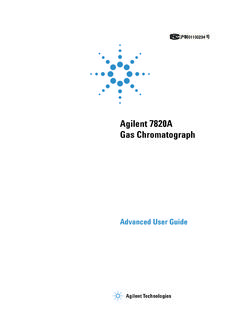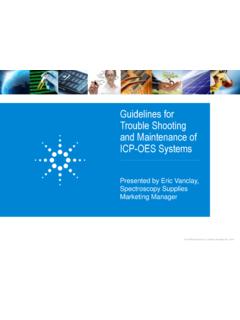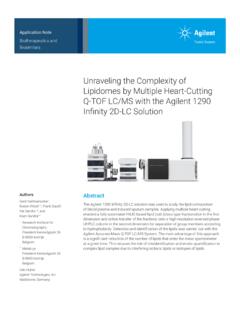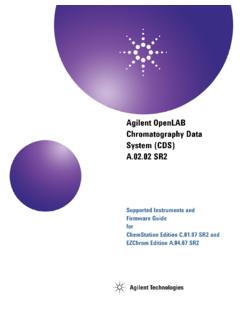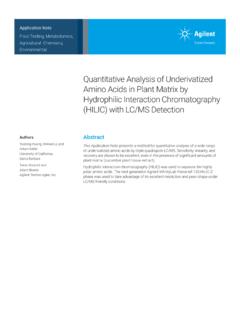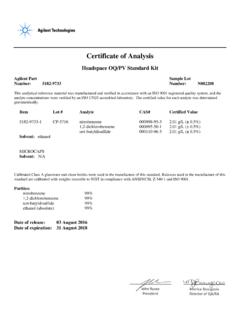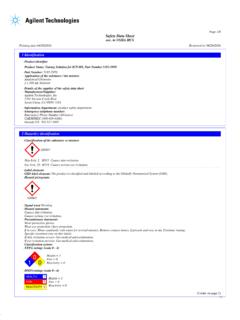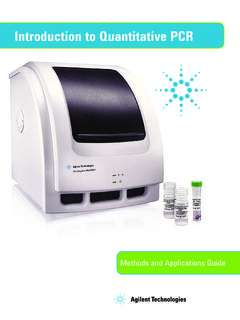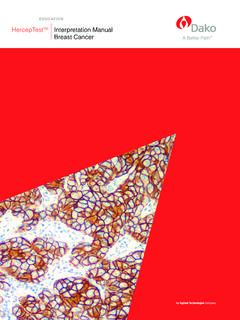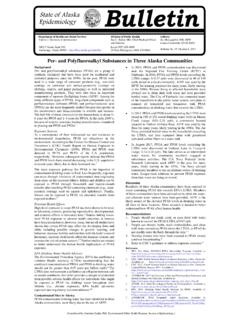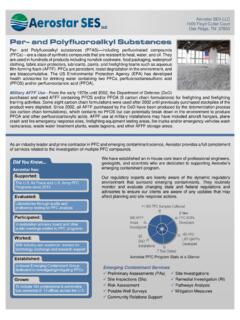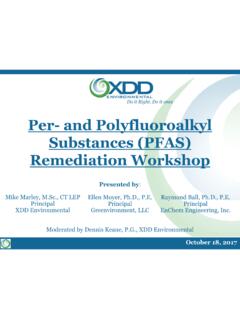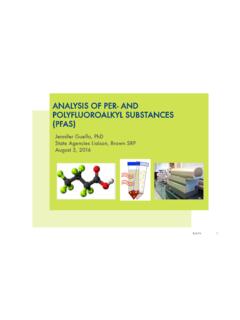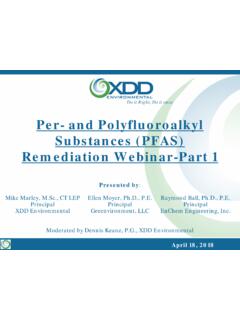Transcription of ANALYSIS OF PER/POLYFLUOROALKYL SUBSTANCES (PFASs) …
1 IntroductionPer/ polyfluoroalkyl SUBSTANCES ( pfass ) are widely used in manufacturing and industry due to their highly desirable properties. They are used as surfactants, fire-retardants, nonstick cookware coatings, and other applications. Because of their unique properties, they have been detected almost ubiquitously in the environment. The United States Environmental Protection Agency (USEPA) has issued drinking water health advisories for two pfass , perfluorooctanoic acid (PFOA) and perfluorooctane sulfonate (PFOS) at 70 ng/L. Several US states also have public health guidelines for pfass ranging from 20 400 ng/L in drinking water. This study describes a method for the sensitive quantification of 17 pfass in drinking water, including all 14 in the USEPAs method 537.
2 The ANALYSIS was performed in a single run using the Agilent Ultivo Triple Quadrupole LC/MS technologies within Ultivo allow for reduction of its overall footprint, while conserving the comparable performance level of much larger MS systems. The numerous innovations of Ultivo not only maximize quantitative performance in a small package, but also enhance instrument reliability and robustness to provide greater uptime. Moreover, Ultivo reduces user intervention for system maintenance, making system operation and maintenance manageable for nonexpert MS OF PER/POLYFLUOROALKYL SUBSTANCES ( pfass ) IN WATERA gilent Ultivo Triple Quadrupole LC/MS SystemFor more information, 1. Agilent Ultivo Triple Quadrupole LC/MS integrated into the Agilent 1290 Infinity II preparationWater samples (250 mL) were extracted using the Agilent SampliQ Weak Anion Exchange (WAX) cartridges.
3 Extraction conditions were similar to those in EPA method 537 with a final extract in 96/4 (v/v) methanol (MeOH)/water. Table 1. Agilent 1290 Infinity II LC columnAgilent ZORBA X Eclipse Plus C18, 50 mm, mAnalytical columnAgilent ZORBA X Eclipse Plus C18, 50 mm, mInjection volume5 LColumn temperature50 CFlow mL/minMobile phaseA) 5 mM Ammonium acetate in water B) 5 mM Ammonium acetate in 95 % MeOHRun minutesTable 2. MRM transitions and RT for 17 ionProduct ion (secondary transition)RT (min) (80)7. 0 (119) (169) (80) (169) 5 PFNA463419 (169)11. 9 (80)11. 9 5 PFDA513469 ( ) ( ) ( ) ( ) (80) ( ) (169) 0 PFTeDA713669 (169) 3. LC Gradient (min)% 4. Agilent Ultivo Triple Quadrupole LC/MS temperature230 CGas flow rate5 L/minSheath temperature350 CSheath flow rate12 L/minNebulizer45 psiCapillary2,500 VNozzle0 VIonizationNegative, ESILC/Triple quadrupole instrument conditionsResults and DiscussionInstrument performanceExcellent peak shapes and sensitive detection of all pfass in water were achieved with the Ultivo 2.
4 LC/Triple quadrupole chromatogram of 17 pfass analyzed at ng/mL. (%)Acquisition time (min)Linearity and sensitivityAll 17 pfass , with 4 14 carbon chain length, had linear calibration curves with R2 > Quantification using a seven-point calibration curve at , , , , , 10, and 20 ng/mL was performed for all water 3. Calibration curves for PFOS, PFOA, N-Et FOSA A, and PFBS. (ng/mL)PFOSy= *x + = 104024681012141618200123456 CountsConcentration (ng/mL)PFOAy= *x + = (ng/mL)N-EtFOSAAy= *x + = (ng/mL)PFBSy= *x + = and % RSDF igure 5 shows the recovery of the 17 pfass determined at 1 g/L (4 ng/L equiv. in water) and 5 g/L (20 ng/L equiv. in water) post-spiked into a drinking water extract.
5 The overall recovery was between 70 125 % for both spiking levels. Relative standard deviation (RSD) was % for all compounds at both the 1 g/L and 5 g/L spike = minutesAcquisition time (min)Figure 4. PFNA peak shape and retention time stability at 1 ng/mL with five replicate 5. Recovery and %RSDs for the pfass evaluated at 1 and 5 ng/mL post-spiked into a water (%)1 g/L Post spike5 g/L Post spikeTable 5. Precision expressed in %RSD for the 17 pfass post-spiked at 1 g/L in a water extract (n = 5).Compound% ug/L post spike is equivalent to 4 ng/L in the original water sampleCompound% in real water samplesFinished drinking water samples from Northeast USA were analyzed for the 17 pfass using the extraction and ANALYSIS technique mentioned here.
6 Figure 6 depicts the presence of PFOS and PFOA detected at low ng/L levels in two samples along with the quantifier ion. The Ultivo was able to detect the presence of these low concentration pfass , suggesting good sensitivity and robustness for the ANALYSIS of water 6. Overlay of qualifier and quantifier ion for PFOS and PFOA detected in finished drinking water samples at low ng/L levels using an Agilent Ultivo LC/ TQ. time (min) ng/L time (min) ng/LConclusionsThe Agilent Ultivo Triple Quadrupole LC/MS provides sensitive, reliable, and robust quantification of PFAS in water, including: Excellent sensitivity for PFAS ANALYSIS with a reduced footprint Good recoveries and low RSDs achieved through innovative technologies Complete workflow and solution for PFAS ANALYSIS that includes the Agilent 1290 Infinity II LC, Ultivo Triple Quadrupole LC/MS, and Agilent MassHunter , descriptions and specifications in this publication are subject to change without notice.
7 Agilent Technologies, Inc. 2017 Published in USA, June 22, 2017 5991-8156 ENRev
